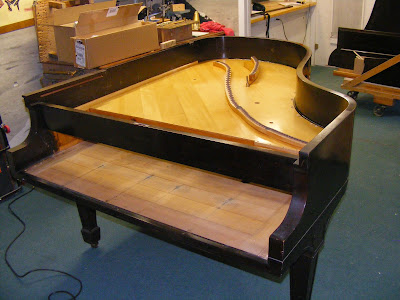Monday, September 15, 2014
Steinway A #280251 Final
It has been 6 months since I last posted here. It has been a very busy 6 months with 4 major rebuilds happening at once. I am grateful for the full schedule, but am glad to be finishing up the second of these projects. After the bridges were glue to the soundboard, the board was finished and installed. Following that the piano was sent to the refinisher.
Finally, the finished product. All action and damper work was completed after the new strings were installed.
Saturday, March 22, 2014
Steinway A #280251 Bridge work
After the proper thickness is determined, the bridge tops are planed, and sanded smooth. The bridge pin hole locations are placed on the new top using the patterns made earlier. Then the holes are drilled, the top dyed black, and the bridge is notched. Finally the new pins are installed.
Tuesday, March 18, 2014
Steinway A 280251 Setting the bearing
Setting the bearing involves planing the tops of the new bridge caps to the correct thickness. The goal is to achieve proper overall down bearing as well as correct front and rear bearing. This is achieved by dry fitting the bridges to the soundboard, and dry fitting the soundboard into the piano. The plate is then installed at it's intended location, and a string is used to determint the new string line. A small kurf is cut in the bridge at numerous locations at the desired height and angle. These notches are then used as a guide to plane the entire bridge top to the correct thickness and angle.
Wednesday, February 26, 2014
Steinway A 280251 Pinblock Fit to plate
Installing a new pinblock requires the rebuilder to mate the wooden pinblock perfectly to the cast iron plate. I a Steinway it also needs to be perfectly fit toe the case, with ends tight and the front mated with the stretcher. The pinblock must also be the correct thickness and also located correctly both side to side and front and back. The pictures below tell some of the story.
Friday, February 7, 2014
Steinway A 280251 Bridge work
This post will review re-capping the bridges. In summery, the bridge pins are removed, patterns are made, and then the caps of the bridges are removed with the band saw. The original bridge bodies are then reused by filling the old holes with wooden pegs, and gluing a new cap of quarter sawn hard rock maple. At a later time the caps will be planed to the correct thickness (setting the bearing) and the patterns will be used to locate the new bridge pins.
Pins have been removed, and pattern has been made and indexed.
Caps removed, and old pin holes filled.
After bridge body has been planed, new cap is prepared, and then glued to original bridge body.
Tuesday, January 28, 2014
Steinway 250281 Soundboard Built
A soundboard begins as a pile of very high quality Sitka Spruce from Washington state. It is perfectly clear, straight grained, and quarter sawn. The wood used is only the best of the best, and I might add, very expensive. The individual boards are laid out according to grain direction and overall size needed for the panel that will be constructed.
I then glue the boards together in widths of about 12" so I can plane them to the desired thickness in my thickness planer. This board was planed to 11/32".
The five panels are then glued into one large panel.
Using the old board as a pattern, the new board is cut to shape, but slightly oversized.
Meanwhile the rib stock is cut and shaped to fit precisely in the notches cut into the rim of the piano. The ribs are also quarter sawn spruce.
The spruce panel is then carefully hand fit into the rim of the piano. The goal is to match the shape of the board to the shape of the rim, with no gaps between the edge of the panel and the inside of the outer rim.
The ribs are indexed to the new soundboard, and then glued to the soundboard panel. The wood is dried to 5%EMC. The pneumatic press exerts 100PSI pressure to the glue line. The board is left in the press overnight.
Project completed. The old beside the new. Next up- bridges to be recapped, and new pinblock installed. These projects will take a few weeks, so see you then.
Sunday, January 19, 2014
Steinway A 280251
I have recently begun a new project. This will be a total restoration. The first step is to remove all case parts, and then the strings, and finally the soundboard, bridges and pinblock. Then the real work begins.
Case parts are removed, measurements are taken and recorded.
Strings removed
Cast iron plate removed with winch.
Sounding Board removed. It literally has to be broken out of the piano. It will be reconstructed to use as a pattern for the new board.
Bridges are removed from sounding board. The bridges will be recapped, using the original bridge bodies.
Pinblock removed. The original is glued and doweled into the case. Not an easy job to remove.
Subscribe to:
Posts (Atom)











































